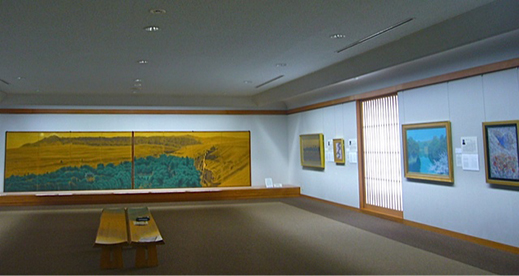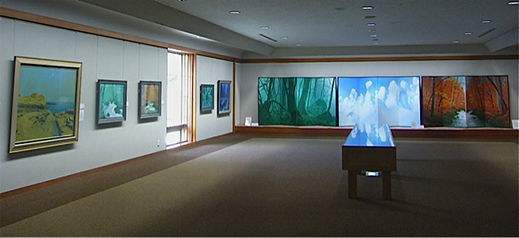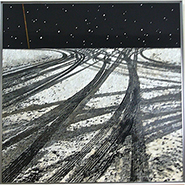 |
|
Here and There introduces art, artists, galleries and museums around Japan that non-Japanese readers and first-time visitors may find of particular interest. The writer claims no art expertise, just a subjective viewpoint acquired over many years' residence in Japan.
|
|
 |
|
|
 |
 |
Nihonga on the Lake: Hakone's Narukawa Art Museum
Alan Gleason |
 |
|
View of Lake Ashi, the Hakone mountains, and Mt. Fuji, from the Panorama Lounge window. Photo courtesy of the Narukawa Art Museum
|
We're in a small museum in the Hakone mountains 50 miles southwest of Tokyo, but the lobby is filled with a crowd of tourists from Europe, listening to a talk by chief curator Katsuyoshi Kohara, via interpreter. A few minutes ago Kohara was manning the ticket counter; now he is enthusiastically describing the artists currently on display, as well as touting the glorious view from the picture window behind the group.
It's a scene that sums up tidily the virtues of the Narukawa Art Museum. Perched on a hillside overlooking lovely Lake Ashi, on clear days it offers a classic vista of Mt. Fuji. For the perfect photo-op, a bright orange torii gate, part of Hakone Shrine, juts out of the lake in the foreground. Kohara remarks that NHK, Japan's national TV broadcaster, has installed a 24-hour Fuji-cam on the museum roof to share the sight with viewers nationwide.
|
View through the two main galleries on the first floor of the Narukawa Art Museum. |
Perhaps it's the view from the Panorama Lounge that draws a steady stream of visitors, many from overseas, to the Narukawa, but they also leave with a thorough introduction to contemporary Nihonga -- "Japanese-style painting" -- under their belts. The museum has clearly made an effort to accommodate non-Japanese guests, providing English translations of most of its exhibit texts.
Founded by businessman Minoru Narukawa in 1988 to house his personal Nihonga collection, the museum owes its location to his business acumen. As Kohara explains, Narukawa wanted to ensure that the facility would continue to attract visitors for years to come. That would depend, in large part, on location -- so he did a survey of favorite scenic spots in Japan, and concluded that a view that included Fuji was a sure winner. It was a good call.
Stunning as the vista is, it would not be enough to keep visitors coming back without the tasteful selection of art on the walls inside. The holdings are large enough (over 4,000 items at last count) to allow the museum to rotate through four multi-artist Nihonga exhibitions a year, and its four spacious galleries enable it to run concurrent exhibits devoted to specific artists. Until June 16 there are several shows worth checking out.
 |
|
Installation view of The Sparkling World of Nihonga, with Ikuo Hirayama's Mingsha Sand Dune, Dunhuang (1985) on the far wall. |
In the large first-floor gallery one finds The Sparkling World of Nihonga, a general introduction to contemporary work in the genre that highlights a dozen artists, some living, some dead, but all active in the postwar years. Dominating the room is a mural-size painting, Mingsha Sand Dune, Dunhuang, by Ikuo Hirayama (1930-2009), one of the acknowledged masters of postwar Nihonga. Sprawling across two four-panel folding screens that extend the entire length of one wall, the work exemplifies Hirayama's bold approach to color: two-thirds of the landscape is in the monochromatic ochre of the Gobi Desert, with the remaining third given over to the contrasting green of the ancient oasis. Like many Nihonga artists of his generation, Hirayama was attracted to central Asia and the Silk Road, a region that offered ample opportunities in color and composition to break away from the bird-flower-animal conventions of traditional Nihonga. Overall, though, this is a fairly orthodox sampling that leans heavily toward the genre's more decorative extremes. Flowers and animals (who are usually portrayed gazing at flowers) indeed abound. In the hands of some artists, like Susumu Maki (b. 1936), Matazo Kayama (1927-2004), and Fumiko Hori (b. 1918), such motifs are used in expressive and novel ways; elsewhere they merely seem kitschy.
 |
|
Installation view of the Kazuyuki Futagawa exhibition at the Narukawa Art Museum.
|
More impressive are two solo exhibitions that occupy separate galleries on the second floor: one by Nihonga painter Kazuyuki Futagawa (b. 1954), the other by lacquer artist Tsunenobu Namiki (b. 1949). Each alone is worth the price of admission. Added to the main exhibit downstairs, they make a tour of the museum's current offerings a bargain indeed.
Kazuyuki Futagawa, Green Trees (2011), two-panel screen. Photo courtesy of the Narukawa Art Museum |
|
Kazuyuki Futagawa, Deep Green Forest (2010), four-panel screen. |
Even from the entrance, Futagawa's space is stunning to behold. The walls are covered with large landscapes, some framed, some on folding screens, that depict natural settings in near-photorealistic detail. This is a considerable departure from standard Nihonga, which may emphasize outlines but tend to favor softer, gauzier composition. Most breathtaking are several all-green portrayals of Yakusugi, the centuries-old twisted cedars of Yakushima island in southern Japan. In Green Trees, the gnarled roots are so pristinely delineated that one could easily mistake this for a work of computer graphics. The far wall is devoted to a dramatic triptych of screen paintings dominated by disparate colors -- Yakushima's Deep Green Forest, the white against blue of Zao's Snow Monsters, and the crimson foliage of Autumn Colors of Oirase River.
 |
|
 |
|
Lacquer paintings by Tsunenobu Namiki on display at the Narukawa Art Museum.
|
|
Tsunenobu Namiki, Sign of Snow (2009); lacquer, quail eggshell, gold powder, colored lacquer. |
Namiki is not a Nihonga artist per se, but his contemporary lacquer paintings share the same natural materials and sensibility. The jet-black lacquer ground sets off his landscapes and seascapes to sublime effect. Most appear to be night scenes, though not all -- in Calm Sea the light of the setting sun reflecting off the ocean is realized with subdued gold inlay. Gold leaf is used for the full moon and the cherry trees blooming at night as well. But some of his loveliest works are in stark black and white, like Sign of Snow, where car tracks on a snowy road evoke abstract sumi brushwork. A display case provides a quick course in lacquer painting and the materials Namiki applies to his lacquer backgrounds. In addition to gold leaf and powder, they include whitened quail eggshell and mother-of-pearl from an impressive variety of mollusks.
Materials used by Namiki to paint on lacquer, in a display case at his exhibition.
|
The Narukawa has some other fascinating displays as well. One showcase features a small portion of the vast spectrum of pigments used in Nihonga. The case houses over a hundred, but Kohara avers that there are some 10,000 in all. The three main types of pigment are explained: tennen-iwa (natural stone), made of natural substances (not only rocks, but minerals, crystals, shell and coral, too); shin-iwa (new stone), artificially produced from metal oxides; and suihi (water-dry), made of various clays. Adjacent to this rainbow array is a case holding the many brushes and other tools of the trade.
Display of over 100 Nihonga pigments in a case on the first floor of the museum.
|
An extra treat is a small exhibit in the lobby of six Noh masks -- all female, all highly stylized, yet exquisitely subtle in the different expressions they convey. Unlike the quiet, austere ambience of the galleries, the lobby and the hallway to the Panorama Lounge have a somewhat jumbled quality, as if the owner's enthusiasms exceeded his exhibit space. That enthusiasm, however, is much of what makes the Narukawa special. It is felt in the hands-on presence of the senior staff, whether at the front counter or the small museum shop upstairs (manned by general manager Katsunori Kanagawa, who doubled as our guide to the galleries), and in their eagerness to explain the art to the visitors from all over who troop through on their way to the Panorama Lounge.
Photos by Alan Gleason except where otherwise indicated, by permission of the Narukawa Art Museum.
|
 |
|
| |
570 Moto Hakone, Ashigara Shimo, Kanagawa Prefecture
Phone: 0460-83-6828
Hours: Open all year, 9 a.m. to 5 p.m.
Access: 3-minute walk from Moto Hakone Port on Lake Ashi, Hakone. From Tokyo, take the Tokaido Shinkansen from Tokyo Station to Odawara, or the Odakyu Romance Car express from Shinjuku Station to Hakone-Yumoto. From Odawara or Hakone-Yumoto take the Hakone Tozan bus or Izu Hakone bus to Moto Hakone Port. |
|
|
| |
 |
Alan Gleason
Alan Gleason is a translator, editor and writer based in Tokyo, where he has lived for 30 years. In addition to writing about the Japanese art scene he has edited and translated works on Japanese theater (from kabuki to the avant-garde) and music (both traditional and contemporary). |
|
|
|
|
|
|
|
|
|
 |
|